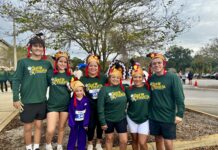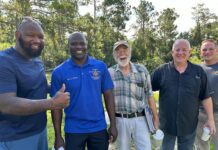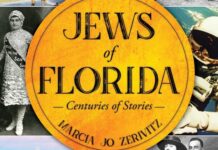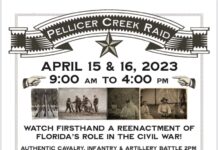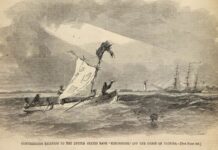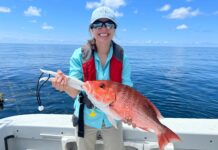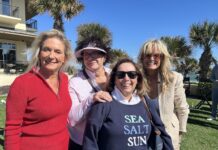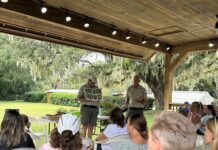Annie Oakley almost crushed to death on the Dixie Highway in Flagler County.
Today we may know her from the Rodgers and Hammerstein Broadway musical, Annie Get Your Gun, but she was not just the best marksman the world had ever seen. She performed before the royalty of Europe. She was received by Queen Victoria. She was such a trusted shooter that Kaiser Wilhelm agreed to let her shoot a cigarette as he held it in his mouth.
She would shoot a dime held by her husband between his finger and his thumb, and she would shoot while riding and also by laying the rifle on her shoulder, shooting over her back, using a mirror; and she beat all men in shooting competitions and became internationally known in Buffalo Bill’s Wild West Show in which she performed with Sitting Bull.
Her career took her far and wide, but what brought her to Daytona Beach was a car wreck. After a hiatus in her 38-year career, Annie Oakley returned to shooting performances in 1922, and her biographer Shirl Kasper has written that Oakley’s popularity was so great that in October at the Brockton, Mass., annual fair she was paid $700 for five exhibitions lasting only five minutes each. Although it was an unseasonably sweltering hot October 5th, 100,000 people came to the fairgrounds –a chance to see Annie Oakley’s shooting was not to be missed.
A month later Annie Oakley and her husband took a boat to Jacksonville, Florida, where they sent their beloved dog, Dave, by train ahead of them to Leesburg, and on Thursday, Nov. 9, they continued their trip with their friends J. J. Stoer and his wife.
The Daytona Beach Morning Journal reported the following Saturday that they were in a ”big Cadillac” driven by “a Mr. Young,” the Stoers’ chauffeur, heading south toward Daytona Beach on their way to Leesburg for the winter.
Cadillacs were luxurious even then, and they all came equipped with a powerful V8 engine. The year before this, 1921, two Cadillacs (a sedan and a touring car) had raced in the prestigious Monaco Concours d’Elegance. Touring cars were open-bodied, seating four or more people, and they were especially popular until closed-bodied cars became less expensive during the 1920s. (In 1920 the Cadillac factory in Detroit had 77 buildings and 6,000 employees.)
The 1921 Cadillac models included a seven-passenger touring car, a seven-passenger open car, and a five-passenger sedan. These automobiles sold for as much as $5,090 the same year that the Model T Ford cost $370. For $5,000 in 1921 a person could buy an entire farm. Annie Oakley was riding in style.
Traveling at what must have been a high speed, the Cadillac’s tires likely were growling a whirring noise as they raced over the red bricks of the Dixie Highway about 46 miles north of Daytona Beach when they passed another vehicle and the tires slipped off the bricks into what was likely a soft shoulder alongside the highway, causing the chauffeur to lose control. As he attempted to steer the huge car back onto the bricks, the Cadillac careened into the roadside and “turned turtle,” pinning Annie Oakley under the massive car.
The Daytona Beach Morning Journal reported that their car was “forced into the sand by a passing machine” and that Oakley was “in a critical condition.”
Oakley was barely five feet tall, and during most of her years in Buffalo Bill’s Wild West Show she weighed only a little over 100 pounds. The Cadillac, which weighed more than two tons, fractured her hip and right ankle. What may have saved her, though, was that behind their car was a Mr. B. Benson of Fort Pierce who helped free her and drove her hurriedly to Daytona Beach.
A gray automobile sped toward the entrance of Bohannon Hospital and Sanitarium in Daytona, Florida, on November 20, 1922, and jerked to a stop. Nurses and doctors scrambled out the building to meet the vehicle. The driver jumped out and raced to meet the medical team. He flung the back door of the car open and removed the limp body lying on the seat. The doctors surrounded the disheveled figure and immediately began examining the unconscious patient. Annie Oakley was pale and bruised, and the sheet under her head was stained with blood from a cut over her right eye. It was a mad dash to get the sixty-two-year-old woman inside the building and into the emergency room.
There, Oakley was admitted to Dr. Bohannon’s Hospital and Sanitarium, run by respected physician Clyde C. Bohannon. When she was stabilized, her husband went to Leesburg to retrieve their dog, and the husband and dog then rented a room near the hospital.
Dave was a black, tan, and white English setter and was loved by this couple who had no children. Oakley’s biographer Shirl Kasper noted that Oakley’s husband, Frank Butler, wrote and published The Life of Dave, As Told by Himself, written as though the dog were speaking: “She looked very feeble and could only put out one hand to stroke my head . . . . By putting my feet on a chair I managed to get close enough to lick her ear. . . . I didn’t like the nurses there, as they seemed rough and hurt my mistress when they moved her.”
After Oakley recuperated for several weeks through November and December, she was released from Dr. Bohannon’s care. But she was forced to wear a heavy metal brace on her right leg, and she still had to walk with crutches when she, her husband, and their dog finally left Daytona Beach.
In Leesburg, Florida, 10 months later on October 8, 1923, she once again stunned the crowds with her rifle, and although she had to set aside her crutches and stand entirely on her good left leg, she “winged pennies tossed in the air at twenty feet,” Kasper wrote, and several times she tossed five eggs at once into the air with her left hand and shot every one before it hit the ground.
The real Annie Oakley came to Daytona in 1922, but she came either to recuperate or to die.
Many of us today are unaware that at one time Annie Oakley was the most famous woman in the United States, possibly the most famous woman in the entire world.
Sixty-three-year-old Annie Oakley was still the greatest marksman in the world.
Annie Oakley in 1922. Photo: U.S. Library of Congress
Credit – Denny Bowden
Credit – Chris Eness
“A Look Back” presented by Flagler County Historical Society
The lure to Florida after the Dixie Highway was built, must have been somewhat of a siren’s song as nationally recognized people traversed the road just as our person in today’s story; Annie Oakley. – James Dean Fiske






